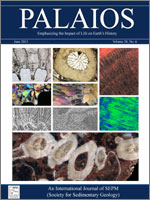In the western North Atlantic and Gulf of Mexico, isotope sclerochronology and field studies of the hard clams, Mercenaria mercenaria and M. campechiensis, collected across a latitudinal gradient show patterns in the seasonal timing of slow versus fast shell incremental growth. It is unknown, however, if similar patterns exist in the eastern North Atlantic. The European limpet, Patella vulgata, is abundant in rocky shore communities and archaeological deposits along the eastern North Atlantic. As such, it is a potentially valuable archive for paleoclimate and archaeological research. We used isotope sclerochronology to identify the seasonal timing of annual growth line formation in shells from the cold- and warm-temperate zones and at the boundary between these zones. Four shells from the cold-temperate zone (United Kingdom and Norway), five shells from the warm-temperate zone (Spain), and six shells from the boundary (near the English Channel) were analyzed. The isotopic records represent between two and eight years of growth. Cold-temperate shells formed annual lines in winter, and warm-temperate shells produced annual lines in summer. A mixed pattern was found at the boundary. This pattern in the seasonal timing of slowed growth across a latitudinal gradient is similar to that shown in studies of Mercenaria in the western North Atlantic. Thermal tolerance is the most likely mechanism for the observed changes in the timing of annual growth line formation with latitude.
BioOne.org will be down briefly for maintenance on 17 December 2024 between 18:00-22:00 Pacific Time US. We apologize for any inconvenience.
How to translate text using browser tools
1 July 2013
ISOTOPE SCLEROCHRONOLOGY AND SEASON OF ANNUAL GROWTH LINE FORMATION IN LIMPET SHELLS (PATELLA VULGATA) FROM WARM- AND COLD-TEMPERATE ZONES IN THE EASTERN NORTH ATLANTIC
DONNA SURGE,
TING WANG,
IGOR GUTIÉRREZ-ZUGASTI,
PATRICIA H. KELLEY
ACCESS THE FULL ARTICLE
It is not available for individual sale.
This article is only available to subscribers.
It is not available for individual sale.
It is not available for individual sale.

PALAIOS
Vol. 28 • No. 6
June 2013
Vol. 28 • No. 6
June 2013




